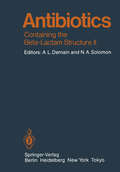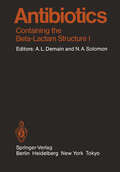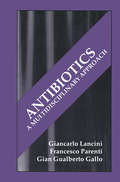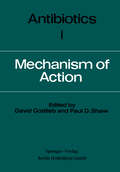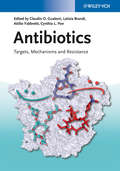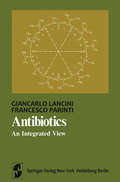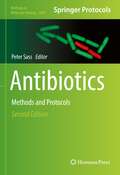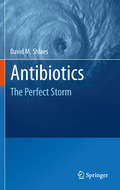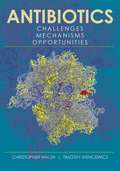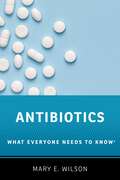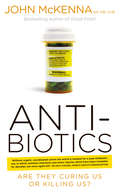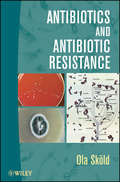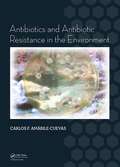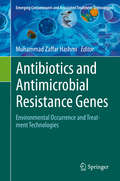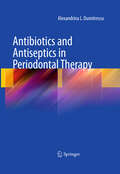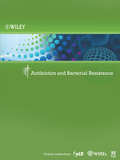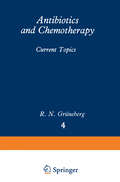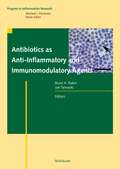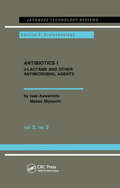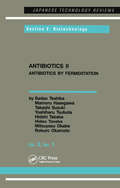- Table View
- List View
Antibiotics: Containing the Beta-Lactam Structure Part II (Handbook of Experimental Pharmacology #67 / 2)
by P. Actor M. C. Browning N. H. Georgopapadakou J.R.E. Hoover K. C. Kwan A. K. Miller J. D. Rogers R. B. Sykes B. M. Tune J. V. UriAntibiotics: Containing the Beta-Lactam Structure (Handbook of Experimental Pharmacology #67 / 1)
by Arnold L. Demain Nadine A. SolomonAntibiotics: A Multidisciplinary Approach
by G.G. Gallo G. Lancini F. ParentiIn this translation of the Italian second edition, the authors provide a comprehensive account of the current knowledge on antibiotics. They concisely describe how various scientific disciplines are involved in antibiotics research, development, and use. Their work also discusses the industrial and clinical development of new antibiotics, as well as the questions and controversies related to the function of antibiotics in nature. Antibiotics is richly illustrated with clear chemical structures, drawings, diagrams, and synoptical tables.
Antibiotics: Targets, Mechanisms and Resistance
by Claudio O. Gualerzi Letizia Brandi Attilio Fabbretti Cynthia L. PonMost of the antibiotics now in use have been discovered more or less by chance, and their mechanisms of action have only been elucidated after their discovery. To meet the medical need for next-generation antibiotics, a more rational approach to antibiotic development is clearly needed. Opening with a general introduction about antimicrobial drugs, their targets and the problem of antibiotic resistance, this reference systematically covers currently known antibiotic classes, their molecular mechanisms and the targets on which they act. Novel targets such as cell signaling networks, riboswitches and bacterial chaperones are covered here, alongside the latest information on the molecular mechanisms of current blockbuster antibiotics. With its broad overview of current and future antibacterial drug development, this unique reference is essential reading for anyone involved in the development and therapeutic application of novel antibiotics.
Antibiotics: Targets, Mechanisms and Resistance
by Claudio O. Gualerzi Letizia Brandi Attilio Fabbretti Cynthia L. PonMost of the antibiotics now in use have been discovered more or less by chance, and their mechanisms of action have only been elucidated after their discovery. To meet the medical need for next-generation antibiotics, a more rational approach to antibiotic development is clearly needed. Opening with a general introduction about antimicrobial drugs, their targets and the problem of antibiotic resistance, this reference systematically covers currently known antibiotic classes, their molecular mechanisms and the targets on which they act. Novel targets such as cell signaling networks, riboswitches and bacterial chaperones are covered here, alongside the latest information on the molecular mechanisms of current blockbuster antibiotics. With its broad overview of current and future antibacterial drug development, this unique reference is essential reading for anyone involved in the development and therapeutic application of novel antibiotics.
Antibiotics: An Integrated View (Springer Series in Microbiology)
by Giancarlo Lancini Francesco ParentiAntibiotics are among the most widely prescribed drugs in both human and veterinary medicine. Furthermore, they are used to protect plants against bacterial and fungal diseases, to decontaminate the shells of eggs, and to improve weight gain and feed conversion in a variety of food animals. Many antibiotics, in addition, have been esseptial tools in the elucidation of specific cellular functions. Genetic engineering, for example, would not be what it is today without the use of antibiotics in the selection of easily determined genetic markers. Production of antibiotics involves a diverse group of professionals: the fermentation technologist, the bioengineer, the extraction chemist. To im prove productivity, an understanding of the biosynthetic pathway and the mechanisms of its control is often useful. After the more than 40 years since the discovery of penicillin, the biol ogist is still unable to answer basic questions: Why are antibiotics produced by only a small number of microbial groups? What is the function of anti biotics in nature? When we started to teach our course on the science of antibiotics at the University of Pavia and the University of Milan, we realized that there was no book that presented the basic facts and concepts on all aspects of this diverse science. This book therefore arose out of our teaching need. Our experience in the discovery, development, and production of antibiotics has certainly imparted a practical nuance to this book.
Antibiotics: Methods and Protocols (Methods in Molecular Biology #2601)
by Peter SassThis second edition provides state-of-the-art and novel methods on antibiotic isolation and purification, identification of antimicrobial killing mechanisms, as well as methods for the analysis and detection of microbial responses and adaptation strategies. Antibiotics: Methods and Protocols, Second Edition, guides readers through updated and entirely new chapters on production and design, mode of action, and response and resistance. Written in the highly successful Methods in Molecular Biology series format, chapters include introductions to their respective topics, lists of the necessary materials and reagents, step-by-step, readily reproducible laboratory protocols, and tips on troubleshooting and avoiding known pitfalls. Authoritative and cutting-edge, Antibiotics: Methods and Protocols, Second Edition aims to inspire scientific work in the exciting field of antibiotic research.
Antibiotics: The Perfect Storm
by David M. ShlaesAntibiotics are truly miracle drugs. As a class, they are one of the only ones that actually cure disease as opposed to most drugs that only help relieve symptoms or control disease. Since bacteria that cause serious disease in humans are becoming more and more resistant to the antibiotics we have today, and because they will ultimately become resistant to any antibiotic that we use for treatment or for anything else, we need a steady supply of new antibiotics active against any resistant bacteria that arise. However, the antibiotics marketplace is no longer attractive for large pharmaceutical companies, the costs of development are skyrocketing because of ever more stringent requirements by the regulatory agencies, and finding new antibiotics active against resistant strains is getting harder and harder. These forces are all combining to deny us these miracle drugs when we need them the most. I provide a number of possible paths to shelter from this perfect storm.
Antibiotics: Challenges, Mechanisms, Opportunities (ASM Books #30)
by Christopher Walsh Timothy WencewiczA chemocentric view of the molecular structures of antibiotics, their origins, actions, and major categories of resistance Antibiotics: Challenges, Mechanisms, Opportunities focuses on antibiotics as small organic molecules, from both natural and synthetic sources. Understanding the chemical scaffold and functional group structures of the major classes of clinically useful antibiotics is critical to understanding how antibiotics interact selectively with bacterial targets. This textbook details how classes of antibiotics interact with five known robust bacterial targets: cell wall assembly and maintenance, membrane integrity, protein synthesis, DNA and RNA information transfer, and the folate pathway to deoxythymidylate. It also addresses the universe of bacterial resistance, from the concept of the resistome to the three major mechanisms of resistance: antibiotic destruction, antibiotic active efflux, and alteration of antibiotic targets. Antibiotics also covers the biosynthetic machinery for the major classes of natural product antibiotics. Authors Christopher Walsh and Timothy Wencewicz provide compelling answers to these questions: What are antibiotics? Where do antibiotics come from? How do antibiotics work? Why do antibiotics stop working? How should our limited inventory of effective antibiotics be addressed? Antibiotics is a textbook for graduate courses in chemical biology, pharmacology, medicinal chemistry, and microbiology and biochemistry courses. It is also a valuable reference for microbiologists, biological and natural product chemists, pharmacologists, and research and development scientists.
Antibiotics: Challenges, Mechanisms, Opportunities (ASM Books)
by Christopher Walsh Timothy WencewiczA chemocentric view of the molecular structures of antibiotics, their origins, actions, and major categories of resistance Antibiotics: Challenges, Mechanisms, Opportunities focuses on antibiotics as small organic molecules, from both natural and synthetic sources. Understanding the chemical scaffold and functional group structures of the major classes of clinically useful antibiotics is critical to understanding how antibiotics interact selectively with bacterial targets. This textbook details how classes of antibiotics interact with five known robust bacterial targets: cell wall assembly and maintenance, membrane integrity, protein synthesis, DNA and RNA information transfer, and the folate pathway to deoxythymidylate. It also addresses the universe of bacterial resistance, from the concept of the resistome to the three major mechanisms of resistance: antibiotic destruction, antibiotic active efflux, and alteration of antibiotic targets. Antibiotics also covers the biosynthetic machinery for the major classes of natural product antibiotics. Authors Christopher Walsh and Timothy Wencewicz provide compelling answers to these questions: What are antibiotics? Where do antibiotics come from? How do antibiotics work? Why do antibiotics stop working? How should our limited inventory of effective antibiotics be addressed? Antibiotics is a textbook for graduate courses in chemical biology, pharmacology, medicinal chemistry, and microbiology and biochemistry courses. It is also a valuable reference for microbiologists, biological and natural product chemists, pharmacologists, and research and development scientists.
Antibiotics: What Everyone Needs to Know® (What Everyone Needs To Know®)
by Mary E. WilsonVirtually everyone has taken antibiotics. They can be lifesavers -- and they can be useless. What are they? How are they used? And what happens as the effectiveness of antibiotics continues to decline? Antibiotics: What Everyone Needs to Know® examines the personal and societal implications of our planet's most important -- and frequently misused -- medications. In a question-and-answer format, it unpacks the most complicated aspects of this issue, including: How antibiotics are used (and overused) in humans, plants, and livestock; the causes and consequences of bacterial resistance to antibiotics; how the globalized world enables antibiotic resistance to spread quickly; and the difficult decisions ahead for both medical care and the food system. Grounded in the latest scientific research and crafted for general readers, Antibiotics: What Everyone Needs to Know® offers a clear-eyed overview of where we are, and what the future holds, as antibiotics lose their power.
Antibiotics – Are They Curing Us or Killing Us?: The Catastrophic Impact of the Over-prescription of Antibiotics on Our Health
by John McKennaAntibiotics: Are they curing us or killing us?‘Without urgent, co-ordinated action by many stakeholders, the world is headed for a post-antibiotic era, in which common infections and minor injuries which have been treatable for decades can once again kill.’ Dr Keiji Fukuda, World Health OrganizationFor anyone reeling from this recent, shocking statement from WHO, Dr John McKenna is here to help. There is no doubt that there is a massive overuse of antibiotics. This book is for anyone who wants to do something about it.The senseless over-prescription and misuse of antibiotics has rendered them almost useless, posing a catastrophic threat to our health. Superbugs are making hospitals increasingly dangerous places to seek help and experts predict we will soon regress to a time when simple infections and medical procedures threaten our lives once again.Dr McKenna, a retired medical doctor who has been practising natural medicine for over 25 years with astonishing results, examines the issues at play. He reveals the truth about the pills your doctor prescribes you and details the often unknown side effects they can have.ANTI-biotics has all the information you need to take your health into your own hands. You will learn how to recognise when antibiotics are hindering you instead of helping you, and discover natural alternatives to restore your health and strengthen your immune system.Through a number of case histories, Dr McKenna shows the effects of MRSA, C. Difficile, TB, E. Coli and other infections that have developed antibiotic resistance. He explains, in layman’s terms, the science of how different antibiotics affect different parts of the immune system.His advice will help you take control of your health with practical tips to boost your immunity and to avoid misusing antibiotics.
Antibiotics and Antibiotic Resistance
by Ola SköldThis book, which is the translated version of a Swedish book, combines a general introduction of a variety of antibiotics with a more in-depth discussion of resistance. The focus on resistance in learning about antibiotics will help future scientists recognize the problem antibiotics resistance poses for medicinal and drug-related fields, and perhaps trigger more research and discoveries to fight antibiotic resistant strains. Current overviews of the topic are included, along with specific discussions on the individual mechanisms (betalactams, glycopeptides, aminoglycosides, etc) used in various antibacterial agents and explanations of how resistances to those develop. Methods for counteracting resistance development in bacteria are discussed as well.
Antibiotics and Antibiotic Resistance
by Ola SköldThis book, which is the translated version of a Swedish book, combines a general introduction of a variety of antibiotics with a more in-depth discussion of resistance. The focus on resistance in learning about antibiotics will help future scientists recognize the problem antibiotics resistance poses for medicinal and drug-related fields, and perhaps trigger more research and discoveries to fight antibiotic resistant strains. Current overviews of the topic are included, along with specific discussions on the individual mechanisms (betalactams, glycopeptides, aminoglycosides, etc) used in various antibacterial agents and explanations of how resistances to those develop. Methods for counteracting resistance development in bacteria are discussed as well.
Antibiotics and Antibiotic Resistance in the Environment
by Carlos F. Amabile-CuevasThe presence of antibiotics, antibiotic resistance genes, and antibiotic resistant bacteria in the environment is a cause of growing worldwide concern, as it reveals the extensive impact of antibiotic abuse and other human-related pressures upon microbes. The field of detecting and measuring resistance in the environment has rapidly evolved to a systematic search of organisms and genes. This book will review the available evidence and hypotheses on where antibiotic resistance is coming from and for how long it has been there. Further, it will discuss involved maintenance pressures, resistance spread, traits and laboratory and in-silico strategies to further investigate antibiotic resistance.
Antibiotics and Antibiotic Resistance in the Environment
by Carlos F. Amabile-CuevasThe presence of antibiotics, antibiotic resistance genes, and antibiotic resistant bacteria in the environment is a cause of growing worldwide concern, as it reveals the extensive impact of antibiotic abuse and other human-related pressures upon microbes. The field of detecting and measuring resistance in the environment has rapidly evolved to a systematic search of organisms and genes. This book will review the available evidence and hypotheses on where antibiotic resistance is coming from and for how long it has been there. Further, it will discuss involved maintenance pressures, resistance spread, traits and laboratory and in-silico strategies to further investigate antibiotic resistance.
Antibiotics and Antimicrobial Resistance Genes: Environmental Occurrence and Treatment Technologies (Emerging Contaminants and Associated Treatment Technologies)
by Muhammad Zaffar HashmiThis volume summarizes and updates information about antibiotics and antimicrobial resistance (AMR)/antibiotic resistant genes (ARG) production, including their entry routes in soil, air, water and sediment, their use in hospital and associated waste, global and temporal trends in use and spread of antibiotics, AMR and ARG. Antimicrobial/antibiotic resistance genes due to manure and agricultural waste applications, bioavailability, biomonitoring, and their Epidemiological, ecological and public health effects. The book addresses the antibiotic and AMR/ARG risk assessment and treatment technologies, for managing antibiotics and AMR/ARG impacted environments The book's expert contributions span 20 chapters, and offer a comprehensive framework for better understanding and analyzing the environmental and social impacts of antibiotics and AMR/ARGs. Readers will have access to recent and updated models regarding the interpretation of antibiotics and AMR/ARGs in environment and biomonitoring studies, and will learn about the management options require to appropriately mitigate environmental contaminants and pollution. The book will be of interest to students, teachers, researchers, policy makers and environmental organizations.
Antibiotics and Antiseptics in Periodontal Therapy
by Alexandrina L DumitrescuPeriodontal diseases are the major cause of tooth mortality in many industrialized countries and most developing nations. The significance of microorganisms in the development of virtually all types of periodontal disease is indisputable. This book is an encyclopedic collection of data from scientific papers and textbooks that form a sound basis for a thorough understanding of the antibiotics and antiseptics used in periodontal therapy. The prophylactic, systemic, and topical uses of antibiotics are discussed in detail, identifying the indications, advantages, disadvantages, and efficacy of each approach and regimen. The use of antiseptics is also carefully examined, with particular attention to the merits of different delivery methods and oral hygiene agents. The closing chapter addresses the role of non-steroidal anti-inflammatory drugs. This book will be of value to undergraduate and postgraduate dental students, dental hygienists, dental practitioners, and other associated professionals.
Antibiotics and Bacterial Resistance (Life Science Research Fundamentals)
by WileyThe need for novel antibiotics is greater now than perhaps any time since the pre-antibiotic era. Indeed, the recent collapse of many pharmaceutical antibacterial groups, combined with the emergence of hypervirulent and pan-antibiotic-resistant bacteria has severely compromised infection treatment options and led to dramatic increases in the incidence and severity of bacterial infections. This collection of reviews and laboratory protocols gives the reader an introduction to the causes of antibiotic resistance, the bacterial strains that pose the largest danger to humans (i.e., streptococci, pneumococci and enterococci) and the antimicrobial agents used to combat infections with these organisms. Some new avenues that are being investigated for antibiotic development are also discussed. Such developments include the discovery of agents that inhibit bacterial RNA degradation, the bacterial ribosome, and structure-based approaches to antibiotic drug discovery. Two laboratory protocols are provided to illustrate different strategies for discovering new antibiotics. One is a bacterial growth inhibition assay to identify inhibitors of bacterial growth that specifically target conditionally essential enzymes in the pathway of interest. The other protocol is used to identify inhibitors of bacterial cell-to-cell signaling. This e-book — a curated collection from eLS, WIREs, and Current Protocols — offers a fantastic introduction to the field of antibiotics and antibiotic resistance for students or interdisciplinary collaborators.
Antibiotics and Chemotherapy: Current Topics (Current Status of Modern Therapy #4)
by GrünebergThe purpose of this book is to provide reviews of various antibiotic topics which will be of interest to practising clinicians and to microbiologists. It is hoped that enough references have been provided to enable the enthusiast to immerse himself in the source literature. No attempt has been made to cover the whole field, which is well catered for in the numerous works on the subject. Rather, the intention has been to select a number of topics in which there has been a great deal of change in recent years, and to ask an appropriate authority to review the subject. Since I chose the topics, it may be supposed, quite correctly, that I have identified subjects in which I felt myself to require some postgraduate education. The process was something like the well known radio programme in which a castaway is allowed to select a number of gramophone records to take with him to a desert island. I hope that readers will share my interest in the contributions from a number of distinguished contributors to the field of antibiotic chemotherapeutic research. Although I have had the privilege of editing this volume it will be understood that the views expressed by the authors are their own and have not been the subject of editorial review. I am grateful to all the collaborators in this volume, and to the publishers, MTP Press, for their help, and for asking me to undertake the task. R. N.
Antibiotics as Anti-Inflammatory and Immunomodulatory Agents (Progress in Inflammation Research)
by Bruce K. Rubin Jun TamaokiAlthough the potential for immunomodulation has been recognized for many years there has been an explosion of data in this field with relevance especially to the treatment of chronic airway diseases. Most of the work in this field has been conducted by Japanese investigators but in the last decade there has been a body of work outside of Japan that supports and enhances these findings. The book covers basic research like effects on bacteria, anti-inflammatory and mucoregulatory effects, but also clinical results with up-to-date information for the use of such medications to potentially treat diseases as diverse as chronic airway diseases, arthritis, inflammatory bowel disease, and cancer. The volume is intended for pulmonary physicians, researchers in inflammation research, and pharmaceutical companies interested in the development of such agents. It provides background information for the clinician as well as in depth exploration of cutting edge science.
Antibiotics I
by Isao KawamotoThis book reviews more recent studies of antibiotics in Japan. It describes β-lactams and other antimicrobial agents according to the following categories: parenteral cephems and related compounds, oral cephalosporins, penems and carbapenems, monobactams, aminoglycosides, and macrolides.
Antibiotics I
by Isao KawamotoThis book reviews more recent studies of antibiotics in Japan. It describes β-lactams and other antimicrobial agents according to the following categories: parenteral cephems and related compounds, oral cephalosporins, penems and carbapenems, monobactams, aminoglycosides, and macrolides.
Antibiotics II
by Sadao TeshibaThis book reviews more recent studies of antibiotics in Japan. It covers astromicin, application of cyclodextrin in the fermentative production process, production of Bialaphos from a Biochemical Engineering viewpoint, and acyl derivatives of tylosin produced by microbial transformation.
